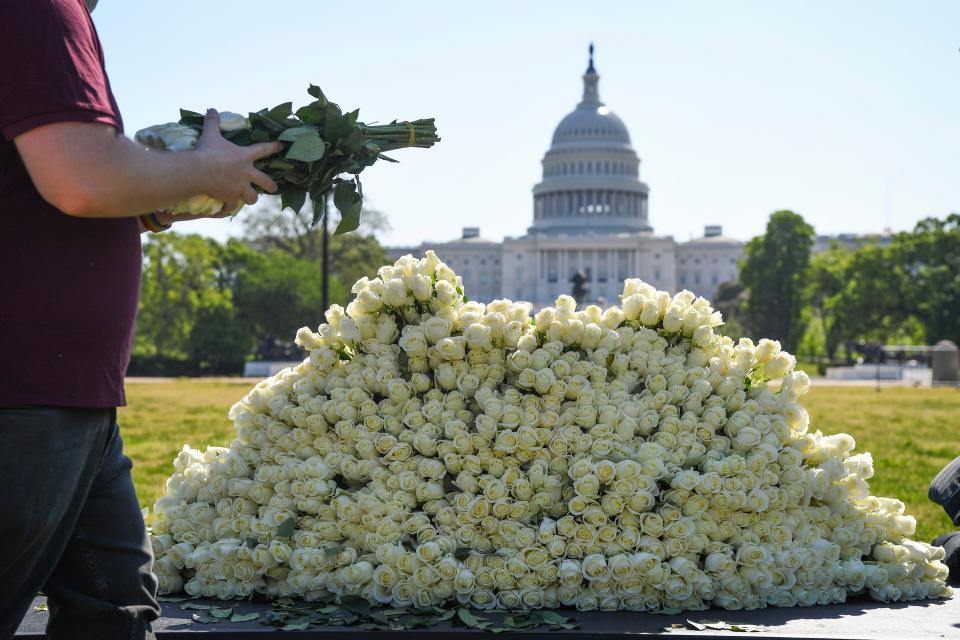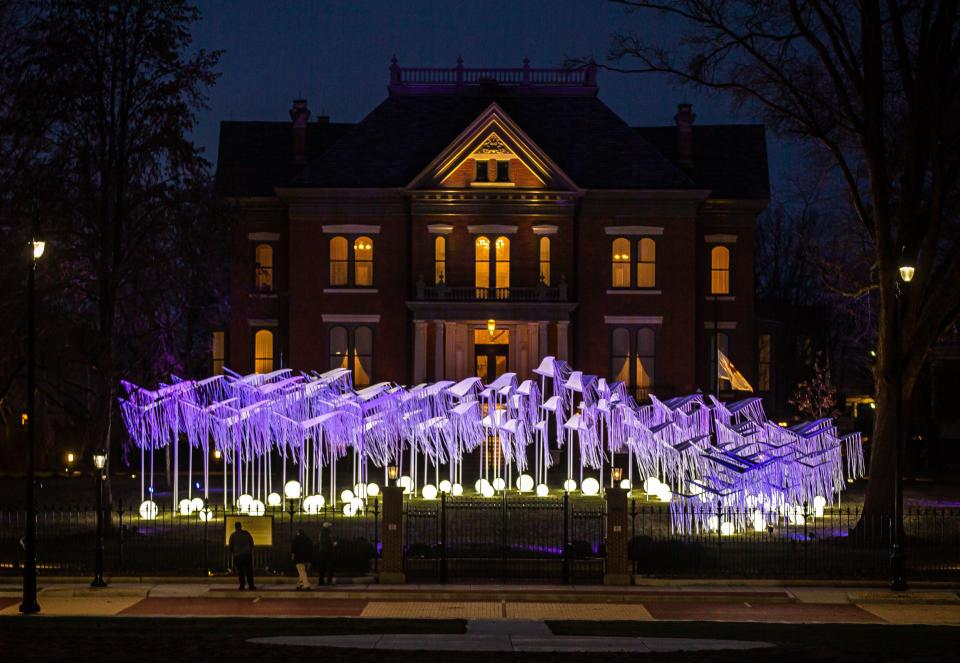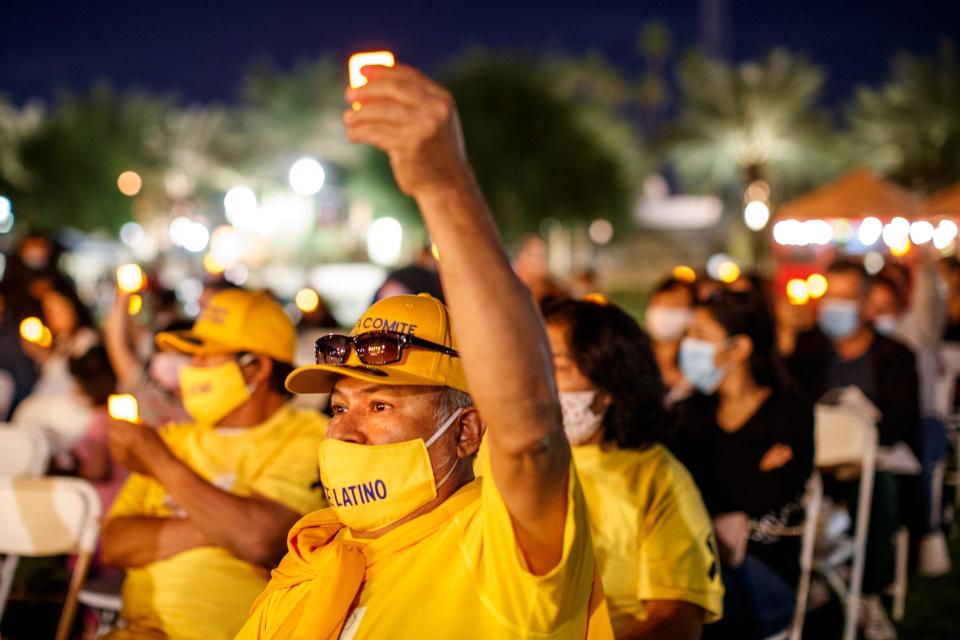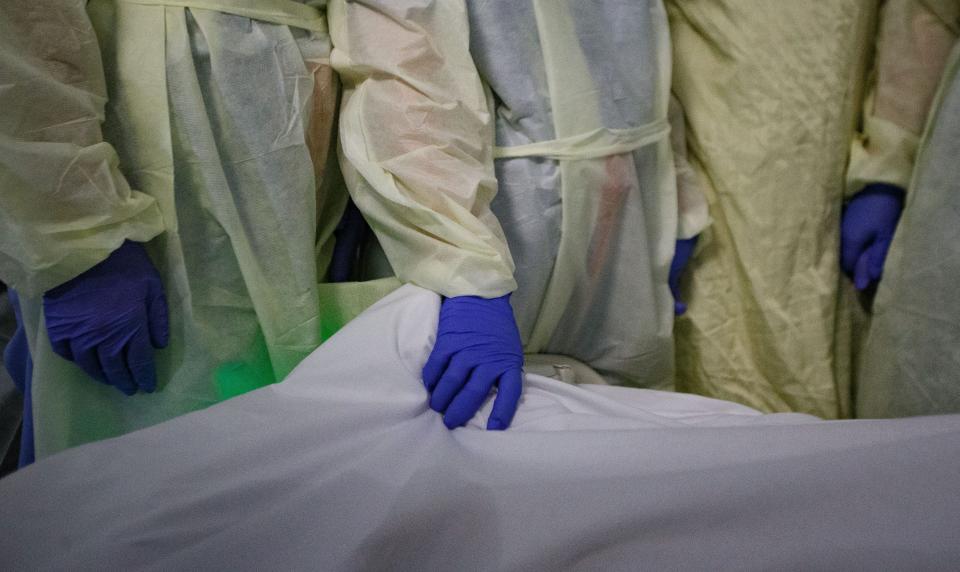A pandemic legacy of grief, anger and frustration
- Oops!Something went wrong.Please try again later.
And now was acknowledged the presence of the Red Death. He had come like a thief in the night…
- Mask of the Red Death, Edgar Allen Poe
The United States is about to hit a grim pandemic milestone: 1,000,000 COVID deaths.
That's a million women, men and children who stopped talking, laughing, working, praying, eating, loving, playing, crying. Breathing.
Angelo Chatman Gist. Linda S. Thornton. Joseph Allen Birt. Antonio Rivas Carillo …
The names represent casualties from the deadliest event in American history, with more lives lost than in any war, earthquake, hurricane or other national disaster.
If you count all U.S. combatant fatalities in every war since the nation’s founding – the Revolution, Civil War, two world wars, Korea, Vietnam, Iraq, Afghanistan and others – the total is not close.
This is what a plague looks like, feels like, does.
COVID-19 has surpassed the U.S. death toll of the 1918 influenza outbreak by a third, and it’s still killing hundreds each day.
Since early 2020, 1 of every 332 Americans has fallen to organisms so tiny that 10,000 would fit in a millimeter.
Monica Alexis. Louisa D’Mello. Anthony C. Dazzo. Martin Addison …
A million caskets and urns, burials and cremations.
Countless families heartbroken, colleagues missed, friends mourned, dreams unfulfilled.
What are we, the survivors, to make of such a morbid benchmark?
Individuals will process the number distinctly based on personal experiences and beliefs. But all are victims.
Have you lost someone close?
Did you get sick and survive? (If yes, you are among more than 75 million Americans who lived to tell about it.)
Were you mostly unaffected except for the lockdowns and quarantines; the masks, social distancing and vaccinations; the inconvenience and ugly politics?
Sometimes, big numbers shock us: Oh, my God, that’s a lot of deaths!
But they can also numb the reality, or realization, of what it all means. One million is amorphous, too many to envision or empathize, just a clump of faceless corpses.
Over the past two years, they were like fallen raindrops, one, then another, and another, and another – a river of death.
It’s not just that each life ended, but the how: Most suffered in quarantined hospital beds for days or weeks, fearful, alone, coughing and gasping and slipping into a coma.
A website, covidmemorial.com, puts their faces, stories and family tributes beneath a headline that insists: “Not forgotten. Not just a number.”
There is no way to fully comprehend the toll without looking closer at just one.
There is no typical victim
Even as a 7-year-old, Braden Wilson described himself as a "quirky kid."
He was the biggest in his class, his mom says, but full of kindness – a "gentle giant" who counted "The Giving Tree" among his favorite books.
Several classmates, perhaps seeing grace as weakness, picked on Braden to a point where he came home bawling and school administrators got involved.
Days later, Amanda Wilson recalls, one of the bullies happened to attend a school dinner and walked by the table where she and her son were seated. Braden cheerfully greeted the boy, inviting him to sit down. "I said, 'Why are you so kind to him? He's mean to you,'" Amanda says. "And he answered, 'Mom, if I don't show him what it is to be kind, he'll never learn.'"
Five years later, classmates at Ascension Lutheran School in Thousand Oaks, California, elected Braden to deliver their valediction. The theme he chose: "It only takes a small deed to brighten someone else’s day."
Braden enrolled at Santa Susana High School in Simi Valley, mulling a future in film editing or computer coding. Then, in December 2020, at age 15, he contracted COVID-19.
Amanda said her son was quickly consumed by sickness: fever, vomiting, shortness of breath. He coded in the local emergency room and was rushed to Children's Hospital Los Angeles, diagnosed with MIS-C, a rare inflammatory syndrome caused by the coronavirus.
Amanda, also sick with COVID-19, shared a room with her only child, who was unconscious, talking to him for days as doctors tried to save his life. "They called every expert. They fought hard for him," she says. "It was just a very difficult time, with him suffering and degrading."
On Jan. 2, 2021, Braden lost the fight.
"He was a beautiful young person, a wonderful boy who was growing into a man," Amanda says, crying softly. "A sweet, kind, caring, empathetic person who wanted to be your friend."
Though it is painful to tell Braden's story, she does so as a tribute and a message: There was no children's vaccine when he got sick, but now deaths are preventable. "I don't understand how this virus picks and chooses," Amanda says. "But every life that's lost is so important, especially to the loved ones. … It's about community. Not just about yourself, but the people around you."
A world view
News organizations, including USA TODAY, have a thing about historic landmarks: We report them, striving to put events in context. But it should be recognized that pegging 1,000,000 deaths on a certain date can be misleading in at least two respects.
First, it requires a distinctly American viewpoint to focus on 1 million U.S. deaths, bypassing the global count of 6 million to 24 million fatalities, depending on whose data is used. (The lower number is based on official government reports, which typically undercount deaths. The higher tally comes from academic research estimates and is based primarily on a count of fatalities exceeding expectations.)
Second, even if one engages in myopic nationalism, there is good reason to believe the United States hit seven digits in coronavirus fatalities weeks ago; it’s just that not all were recorded as such.
The Wall Street Journal, in fact, got a jump on other news outlets, reporting that as of early February, total deaths in the nation during the pandemic had exceeded expectations by 1 million and concluding that the mortality excess was a result of COVID-19.
But, again, these are just numbers …
Lilia Alvarez. Gordon Thawani. Francis Horgan. Julie Jodene Ebel …
COVID-19 is an evolutionary fact, a pathogenic opportunist in a world of 7.9 billion people who are more connected than at any time in history.
The virus does not discriminate. It infects according to its genetic properties, chance and the carelessness or misfortune of humans.
It invades without heed for age, race and gender. But the killing part, that’s not equal opportunity. Death comes more readily to the elderly, the infirm and those socio-economically disadvantaged.
Three-quarters of coronavirus fatalities in the United States are people 65 and older. Hispanics make up 18% of the U.S. population but account for 24% of COVID-19 deaths. Mortality is far higher among those with chronic medical conditions – such as diabetes, heart disease and lung disease.
Kristin Urquiza, whose father in Arizona became a coronavirus casualty during 2020, published an "Honest Obituary" afterward. "His death is due to the carelessness of the politicians who continue to jeopardize the health of brown bodies through a clear lack of leadership," wrote Urquiza, founder of the nonprofit organization Marked By COVID.
For her, 1,000,000 deaths means "there are a million legacies we need to protect, remember and grieve. I'll always have a pit of anger in my stomach because so many of the deaths could have been prevented."

David Dowdy, an epidemiologist at Johns Hopkins Bloomberg School of Public Health, agrees the 1 million benchmark didn't have to happen – or at least came way too early. Since vaccines became available, Dowdy estimates, if every qualified U.S. resident had gotten the shots, 400,000 lives might have been saved.
But Dowdy is philosophical about the "terrible job" America did in response to a pandemic – the politicization, the mixed messages from public health officials, the denial and willful ignorance of citizens.
People are imperfect, he noted. They make mistakes and often do not learn from history. "Is it a colossal failure," Dowdy asked, "or is it a characteristic of humans that this is how we react?"
The future
The dead are history.
What we make of them – how we respond – creates tomorrow.
The nation and world already have experienced social, economic and political upheaval. But anthropologists and historians know that global catastrophes are marked by prolonged shock waves that reverberate into the future.
The Black Plague, for instance, is widely regarded as a contributor to the so-called Dark Ages of Europe after the Roman Empire collapsed. By modern reckonings, it killed millions – 40% to 60% of the Euro-Africa-Asia population – in the 1300s.
But Carol Symes, an associate professor of history at the University of Illinois Urbana-Champaign, said the plague also had “massive social, economic and cultural consequences” through the centuries.
With the population die-off, sterile farmlands recovered and famine was alleviated, Symes said. Peasant workers, suddenly more valuable, launched labor rebellions. The failure of churches and monarchies to combat disease spawned crises in faith and confidence which, in part, triggered the Protestant Reformation, the Renaissance and the overthrow of monarchies.
Among the many lessons, Symes said: “As awful as it is to live through a period like this, it will always end. And history will emerge with something better.”


Michael Ennis-McMillan, a medical anthropologist, said COVID-19 may be new, but the flawed human response to pandemic illness is very old.
Ennis-McMillan, who teaches a course on emerging diseases at Skidmore College, said the social blueprint includes stigmatization, misinformation, politicization and social inequities – behaviors that prolong and expand pandemics.
When the coronavirus pandemic began in early 2020, he added, news focused on the scapegoating of Asians, conspiracy theories, attacks on public health and partisan disputes over science and policy.
“The students were saying: ‘It’s just like what we read about. This is happening,’” Ennis-McMillan recalls. "Now, when we’re reaching a million deaths, some of these were preventable. You have kids who are orphans and parents who don’t have someone to care for them."
When the next pathogen comes, he added, it could be a completely different organism. “And people are going to forget these lessons.”
In an article on COVID-19 and human adaptation, anthropologist Indira Pillay pointed to one, tiny aspect of life in Italy.
To prevent spread of the Black Plague centuries ago, Pillay wrote, wine merchants in Florence were banned from serving customers in the usual way. So, they cut holes in the walls or doors of their homes, passing flasks out and receiving coin payments in return.
Eventually, the wine portals – known as "buchette del vino" – were sealed, Pillay wrote. But, hundreds of years later amid the coronavirus epidemic, many of those holes have been reopened to safely do business – "an indication of human resilience and coping in challenging circumstances."
Beyond sickness and death, COVID-19 may be viewed a thousand years hence as a great transformer – not just for the United States but for the world.
Or, it may be a mere footnote of history.
The pandemic exploded in an era of social disruption that includes global warming, culture wars, political turmoil and, more recently, Russia’s invasion of Ukraine. If history conveys one lesson, it is that change is inevitable. The key questions are always: how and why?
Paul Weinbaum, who spent years as a physician before shifting to a pandemic historian, said COVID-19 is in some respects unique among global outbreaks because modern air travel completely changed the dynamics of transmission, and because the world handled it so poorly.
“One of the great tragedies of COVID-19 was the lack of an integrated, coordinated, international response,” he said.

During other modern disease plagues, such as MERS, SARS and Ebola, public health efforts were unified and international, Weinbaum noted, and pandemic slaughter was prevented.
But not with the coronavirus. Instead, as with the Spanish flu of 1918, nations and communities devised a hodgepodge of health protocols influenced by scapegoating, politics, misinformation and public resistance.
The result: Places with the weakest prevention policies and the most disadvantaged populations suffered the greatest death and disruption.
Does that mean government leaders and public health officials failed to learn from history? “It’s not that they didn’t learn the lessons,” Weinbaum said. “It’s that they did not operationalize what they knew should be done.”
If not for the rapid development of vaccines, he added, COVID-19 would certainly have killed far more than 1 million Americans to date. “Several hundred thousands of lives have been saved, at the very least. … It could have been a lot worse.”
Rick Stacy. Jessie Arbogast. Promela Suri. Kenneth M. Chance …
Memorials
Inevitably, monuments will arise to honor and remember the millions who died.
It’s already started with virtual memorials, where photographs and mini-obits are published online.
And there have been scattered efforts to create something tangible. Last fall, artist Suzanne Firstenberg deployed about 3,000 volunteers to plant more than 670,000 white flags on a lawn outside RFK Stadium in Washington, D.C., each representing an American pandemic victim at that time. Visitors to the memorial were invited to write mementos on the flags – tributes to loved ones lost.
Firstenberg told Art World she came up with the exhibition for a simple reason: “Words aren’t working anymore. … This art represents the pain that we all are suffering.”
But the flag display was temporary. And many, including Spencer Bailey, a journalist and author of “In Memory Of,” a book about memorials, believe a permanent tribute should be created. Not just to honor those who died, Bailey said, but as a unifying device and a message to the future.
Bailey's interest in memorials is personal: In 1989, at age 3, he was among the survivors of an Iowa plane crash that killed his mother and 111 others. That tragedy is commemorated by a sculpture of Bailey in the arms of a rescuer.
When a memorial is done right, Bailey said, it connects cultures and people while evoking emotions: fear, hope, strength, loss, grief.
For COVID-19, Bailey envisions a global network of memorials in each community and nation, based on a singular design, perhaps bearing the names of those who died and a digital link to their stories.
He pointed to the Vietnam Veterans Memorial in Washington, D.C., as an example of art that transcends and transforms: The black granite wall is etched with names of 58,313 service members who died in the war, changing America’s understanding of war and history. Likewise, Bailey said, the Memorial for Peace and Justice in Alabama overwhelms observers with 816 steel monuments – one for each county where a racial-terror lynching occurred.
“A memorial is a form to humble us,” Bailey said. “It gives us pause, makes us turn inward. … These are sites that transform not just those who visit them, but the culture and society beyond.”
If America had erected such a monument after the Spanish flu of 1918, Bailey added, “we probably would have had a very different response (to COVID-19) than the scrambled, quite catastrophic one that we did.”
Terry Busker. Jose Gilbert Del Rio. Rosa Ann Miller. Randy Whipple …
Yes, Randy Whipple, a 78-year-old Vietnam veteran. He died on May 10, 2020, leaving behind two children and a granddaughter. On covidmemorial.com, daughter Jessica left a tribute echoed in many other epitaphs:
“He was a lot of things, but most importantly he was more than just a number.”
This article originally appeared on USA TODAY: 1,000,000 US COVID deaths: A pandemic milestone, a legacy of grief

